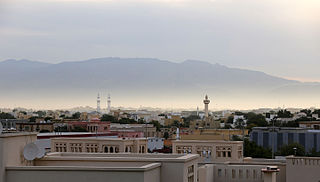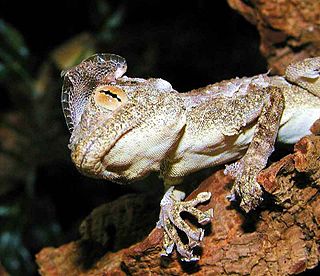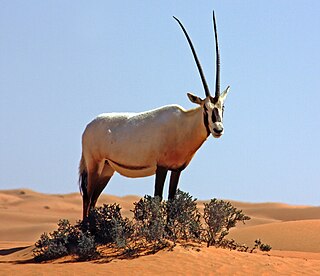
Oman is a country on the southeast coast of the Arabian Peninsula, situated in Southwest Asia, bordering the Arabian Sea, Gulf of Oman, and Persian Gulf, between Yemen and the United Arab Emirates (UAE). The coast of Oman was an important part in the Omani empire and sultanate.

The United Arab Emirates is situated in the Middle East and southwest Asia, bordering the Gulf of Oman and the Persian Gulf, between Oman and Saudi Arabia; it is at a strategic location along the northern approaches to the Strait of Hormuz, a vital transit point for world crude oil. The UAE lies between 22°50′ and 26° north latitude and between 51° and 56°25′ east longitude. It shares a 19 km (12 mi) border with Qatar on the northwest, a 530 km (330 mi) border with Saudi Arabia on the west, south, and southeast, and a 450 km (280 mi) border with Oman on the southeast and northeast.

Ptyodactylus is a genus of geckos, which are commonly known as fan-fingered geckos. The genus has 12 described species.

The Musandam Peninsula, locally known as Ruus Al Jibal, is a peninsula that forms the northeastern point of the Arabian Peninsula. It is located to the south of the Strait of Hormuz between the Persian Gulf and Gulf of Oman. It is inhabited by the Shihuh tribe and is mainly governed by Oman as the Musandam Governorate with certain parts governed by the United Arab Emirates, including Ras Al Khaimah and parts of Dibba.

Jabal Al-Mebraḥ, also known as Jabal Yibir, is a 1,727 m (5,666 ft) tall mountain in the United Arab Emirates (UAE).

The Arabian tahr is a species of tahr native to eastern Arabia. Until recently, it was placed in the genus Hemitragus, but genetic evidence supports its removal to a separate monotypic genus, Arabitragus.
The Shihuh is an Arab tribe living in the United Arab Emirates (UAE) and Oman. In the singular, the name is Al Shehhi, a common family name in the UAE and Oman today. Inhabiting the northern part of the Hajar Mountain range, specifically in the Ruus Al Jibal, the tribe has long been influential in the affairs of both the east and west coast settlements of the northern UAE and Oman and has fiercely maintained both its identity and independence.
Bani Shatair is a tribal name, originating in Ras Al Khaimah, in the United Arab Emirates (UAE) and in areas of Northern Oman.

Jebel Jais is a mountain of the North-Western Hajar range in the Musandam Governorate of Oman and also in Ras Al Khaimah, United Arab Emirates. The summit has an elevation of 1,934 m (6,345 ft). The summit is located on the Omani side, but a high point west of this peak is considered the highest point in the United Arab Emirates, at 1,892 m (6,207 ft) above sea level, and with around 10m of prominence. Since the summit is on the Omani side, Jebel Al Mebrah, at 1,727 m (5,666 ft), is the highest peak in the UAE, with significant prominence.

The Gulf of Oman desert and semi-desert is a coastal ecoregion on the Persian Gulf and the Gulf of Oman in Oman and the United Arab Emirates at the northeastern tip of the Arabian Peninsula. The climate is hot and dry, with gravelly plains and savanna with thorny acacia trees inland from the coast. Along the coast there are mixture of habitats that include mangrove swamps, lagoons and mudflats. The mangrove areas are dominated by Avicennia marina and the savanna by Prosopis cineraria and Vachellia tortilis. Masirah Island is an important breeding area for the loggerhead sea turtle and other sea turtles also occur here, as well as a great variety of birds, some resident and some migratory. There are some protected areas, but in general the habitats have been degraded by the grazing of livestock, especially camels and goats; they are also at risk from oil spills, off-road driving and poaching.

Al-Hajar Mountains in northeastern Oman and also the eastern United Arab Emirates are the highest mountain range in the eastern Arabian peninsula. Also known as "Oman Mountains", they separate the low coastal plain of Oman from the high desert plateau, and lie 50–100 km (31–62 mi) inland from the Gulf of Oman.

Ptyodactylus hasselquistii, commonly known as the fan-footed gecko, Hasselquist's fan-footed gecko, and the yellow fan-fingered gecko, is a species of gecko, a lizard in the family Phyllodactylidae. The species is endemic to northern Africa and western Asia.

The wildlife of the United Arab Emirates is the flora and fauna of the country on the eastern side of the Arabian Peninsula and the southern end of the Persian Gulf. The country offers a variety of habitats for wildlife including the coast, offshore islands, mangrove areas, mudflats, salt pans, sand and gravel plains, sand dunes, mountain slopes, wadis and rocky summits. Because the terrain is so varied, it supports a greater number of species of plants and animals than might have been expected in this relatively small country.

The wildlife of Oman is the flora and fauna of this country in the southeastern corner of the Arabian Peninsula, with coasts on the Gulf of Oman and the Arabian Sea. The climate is hot and dry, apart from the southeastern coast, and the country offers a variety of habitats for wildlife including mountains, valleys, deserts, coastal plains and sea coasts.
Bani Hadiyah is a tribal name, originating in Ras Al Khaimah, in the United Arab Emirates (UAE) and in areas of Northern Oman.

Tawam, also Tuwwam, Tu'am, or "Al-Buraimi Oasis", is a historical oasis region in Eastern Arabia that stretched from, or was located between, the Western Hajar Mountains to the Persian Gulf coast, nowadays forming parts of what is now the United Arab Emirates and western Oman. It is marked by the twin settlements of Al Ain and Al-Buraimi on the UAE-Omani border.
Asaccus margaritae, or Margarita's leaf-toed gecko, is a species of lizard in the family Phyllodactylidae. It is endemic to the Arabian Peninsula and occurs in the United Arab Emirates and Oman. It was first described in 2016.

The Al Hajar montane woodlands is a temperate grasslands, savannas and shrublands ecoregion in the Al Hajar Mountains on the eastern Arabian Peninsula, which extends across portions of Oman and the United Arab Emirates.

Wadi Shie is a seasonal watercourse located in the Eastern Hajar Mountains of Sharjah, in the United Arab Emirates.















